springMVC整理03--处理数据模型 & 试图解析器 & @ResponseBody & HttpEntity
1.处理模型数据
SpringMVC 中的模型数据是非常重要的,因为 MVC 中的控制(C)请求处理业务逻辑来生成数据模型(M),而视图(V)就是为了渲染数据模型的数据。当有一个查询的请求,控制器(C)会把请求拦截下来,然后把根据请求的内容对它进行分配适合的处理方法,在处理方法上进行处理查询的业务逻辑,得到了数据,再把数据封装成数据模型对象,最后把数据模型(M)对象传给了视图(V),让视图去渲染数据模型。SpringMVC 提供了以下几种途径输出模型数据:
- ModelAndView:处理方法返回值类型为 ModelAndView 时,方法体即可通过该对象添加模型数据。
- @ModelAttribute:方法入参标注该注解后,入参的对象就会放到数据模型中。
- Map 及 Model:入参为 org.springframework.ui.Model、org.springframework.uiModelMap 或 java.util.Map 时,处理方法返回时,Map 中的数据会自动添加到模型中。
- @SessionAttributes:将模型中的某个属性暂存到 HttpSession 中,以便多个请求之间可以共享这个属性。
1.1 Map 和 和 Model 入参
1 /** 2 * 当参数为 Map 时 3 * SpirngMVC 会传入 一个 BindingAwareModelMap 4 * 往 BindingAwareModelMap 里面存入的值 会在后面存入 request 域中 5 * 相当于在方法返回前执行了一个 request.setAttribute 的操作 6 */ 7 @RequestMapping("/map.html") 8 public String map(Map<String, Object> map) { 9 System. out .println(map.getClass().getName()); 10 map.put("name", "aaa"); 11 map.put("id", 123); 12 return "/model.jsp"; 13 } 14 /** 15 * 参数为 Model 类型的,作用和 Map 一样 16 */ 17 @RequestMapping("/model.html") 18 public String model(Model model) { 19 model.addAttribute("id",123); 20 model.addAttribute("name","aaa"); 21 return "/model.jsp"; 22 }
测试页面:
1 name=${name}<br/> 2 id=${id}<br/>
运行结果:访问 map.html 或 model.html 的时候,页面上显示: name=aaa id=123
name=aaa id=123
1.2ModelAndView
ModelAndView 既包含数据模型,又包含视图信息
1 @RequestMapping("/modelandview.html") 2 public ModelAndView testModeAndView(){ 3 ModelAndView modelAndView = new ModelAndView(); 4 //将 Model 数据作为 request.attribute Foward 到下一个页面。 5 modelAndView.addObject("id",123); 6 modelAndView.addObject("name","abc"); 7 modelAndView.setViewName("/model.jsp");//设置要返回的页面 8 return modelAndView; 9 }
1.3 @SessionAttributes
若希望在多个请求之间共用某个模型属性数据,则可以在控制器类上标注一个 @SessionAttributes,SpringMVC 将在模型中对应的属性暂存到 HttpSession 中。
@SessionAttributes 只能标注在类上。
@SessionAttributes 除了可以通过属性名指定需要放到会话中的属性外,还可以通过模型属性的对象类型指定哪些模型属性需要放到会话中.
– @SessionAttributes(types=Dept.class) 会将隐含模型中所有类型为 Dept.class 的属性添加到session 中。
– @SessionAttributes(value={“user”,”admin”})会将模型中名为 user 和 admin 的属性添加到session 中
– @SessionAttributes(types={Dept.class, Employee.class})会将模型中所有类型为 Dept 和Employee 的属性添加到 session 中
– @SessionAttributes(value={“user”,”admin”}, types={Dept.class})会将模型中名为 user和 admin和类型为 Dept 的对象放到 session 中。
在类上添加 @SessionAttributes 注解
1 @SessionAttributes(types = Dept.class, value = {"user", "admin"}) 2 @Controller 3 public class ModelController {
测试方法:
1 @RequestMapping("/session.html") 2 public ModelAndView testSettion(Map<String, Object> map) { 3 map.put("admin", "I am admin"); 4 map.put("user", "I am user"); 5 Dept dept = new Dept(); 6 dept.setName("session name"); 7 map.put("dept", dept); 8 //@SessionAttributes 注解里没有声明 other 这个属性,所以不会在 session 中 9 map.put("other", "I'm other"); 10 return new ModelAndView("/model.jsp", "result", map); 11 }
测试页面:
1 request 中的属性:<br/> 2 admin:${requestScope.admin}<br/> 3 user:${requestScope.user}<br/> 4 dept.name:${requestScope.dept.name}<br/> 5 other:${requestScope.other}<br/> 6 session 中的属性:<br/> 7 admin:${sessionScope.admin}<br/> 8 user:${sessionScope.user}<br/> 9 dept.name:${sessionScope.dept.name}<br/> 10 other:${sessionScope.other}<br/>
运行效果:
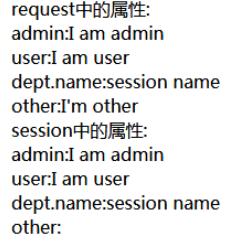
可以看到模型中的属性都放到了request的域中。@SessionAttributes中没有声明other,所以 session 中的 other 是空的。
1.4 @ModelAttribute
1.4.1 方法参数上使用@ ModelAttribute
在参数前使用@ModelAttribute,在进去方法时可以通过参数给对象赋值,如下面的代码,当请求/model1.html?id=1 的时候,会给 dept 的 id 属性赋值。在方法中可以对 dept 做进一步的处理。@ModelAttribute 可以自动将被注解的对象作为数据模型返回给页面。
1 @RequestMapping("/model1.html") 2 public String testModelAttribute(@ModelAttribute Dept dept) { 3 dept.setId(123); 4 dept.setName("test"); 5 //使用@ModelAttribute 注解 dept 6 //相当于执行了 request.setAttribute("dept",dept); 7 //页面上可以直接取数据 8 return "/model.jsp"; 9 }
测试页面 model.jsp,使用 EL 表达式取值 :
1 <body> 2 dept.id=${dept.id}<br/> 3 dept.name=${dept.name} 4 </body
运行结果
1.4.2 定义方法时使用@ ModelAttribute
在方法上使用@ModelAttribute 后,执行这个 Controller 的任意一个方法之前,都会调用这个方法给对象赋值。
1 /** 2 * 在方法上使用@ModelAttribute,调用这个 Controller 任意一个方法之前 3 * 都会执行这个方法给模型赋值 4 */ 5 @ModelAttribute("dept") 6 public Dept getDept() { 7 Dept dept = new Dept(); 8 dept.setId(456); 9 dept.setName("name"); 10 return dept; 11 } 12 /** 13 * 在调用这个方法前,会执行 getDept() 14 * 如果请求中有参数,会覆盖掉 getDept()的值 15 * dept 会作为数据模型返回到页面上 16 */ 17 @RequestMapping("/model2.html") 18 public String testModelAttribute2(@ModelAttribute Dept dept) { 19 System. out .println(dept.getId()); 20 System. out .println(dept.getName()); 21 return "/model.jsp"; 22 }
2. 视图和视图解析器
对于Controller的目标方法,无论其返回值是String、View、ModelMap或是ModelAndView,SpringMVC 都会在内部将它们封装为一个 ModelAndView 对象进行返回。
Spring MVC 借助视图解析器(ViewResolver)得到最终的视图对象(View),最终的视图可以是 JSP 也可是 Excell、 JFreeChart 等各种表现形式的视图。
View ---View 接口表示一个响应给用户的视图,例如 jsp 文件,pdf 文件,html 文件等。
视图的作用是渲染模型数据,将模型里的数据以某种形式呈现给客户。
为了实现视图模型和具体实现技术的解耦,Spring 在 org.springframework.web.servlet 包中定义了一个高度抽象的 View 接口。
视图对象由视图解析器负责实例化。由于视图是无状态的,所以他们不会有线程安全的问题。所谓视图是无状态的,是指对于每一个请求,都会创建一个 View 对象。
JSP 是最常见的视图技术。
2.1 ViewResolver
ViewResolver 的主要作用是把一个逻辑上的视图名称解析为一个真正的视图,SpringMVC
中用于把 View 对象呈现给客户端的是 View 对象本身,而 ViewResolver 只是把逻辑视图名称
解析为对象的 View 对象。
2.1.1 InternalResourceViewResolver
InternalResourceViewResolver 可以在视图名称前自动加前缀或后缀:
1 <!-- 配置视图解析器--> 2 <bean class="org.springframework.web.servlet.view.InternalResourceViewResolver"> 3 <property name="prefix" value="/"></property><!--前缀--> 4 <property name="suffix" value=".jsp"></property><!--后缀--> 5 </bean>
如果配置了上面的解析器,Controller中返回字符串就不需要写/index.jsp了,直接返回“index”,就会按照/index.jsp 去解析
2.1.2 MappingJackson2JsonView
2.1.3 FreeMarkViewResolver
FreeMaker 后面会进行介绍,
FreeMarker 与 spring 整合需要导入 jar:
1 <dependency> 2 <groupId>org.freemarker</groupId> 3 <artifactId>freemarker</artifactId> 4 <version>2.3.23</version> 5 </dependency> 6 <dependency> 7 <groupId>org.springframework</groupId> 8 <artifactId>spring-context-support</artifactId> 9 <version>4.3.11.RELEASE</version> 10 </dependency>
使用 FreeMarker 模板生成静态网页,需要在 springMVC-servlet.xml 中配置:
1 <bean id="freemarkerConfig" 2 class="org.springframework.web.servlet.view.freemarker.FreeMarkerConfigurer"> 3 <!--模板存放路径--> 4 <property name="templateLoaderPath" value="/WEB-INF/ftl/" /> 5 <property name="defaultEncoding" value="UTF-8" /> 6 </bean>
在 WEB-INF/ftl 下创建模板文件 hello.ftl:

1 <html> 2 <head> 3 <title>Title</title> 4 </head> 5 <body> 6 <h1>${hello}</h1> 7 </body>
通过模板生成静态网页:
1 @Controller 2 public class FreeMarkerController { { 3 @Autowired 4 private FreeMarkerConfigurer freeMarkerConfigurer; 5 @RequestMapping( "/freemarker.html") 6 @ResponseBody 7 public String genHtml() throws Exception { { 8 // 1 、从 g spring 容器中获得 r FreeMarkerConfigurer 对象。 9 // 2 、从 r FreeMarkerConfigurer 对象中获得 n Configuration 对象。 10 Configuration configuration = freeMarkerConfigurer.getConfiguration(); 11 // 3 、使用 n Configuration 对象获得 e Template 对象。 12 Template template = configuration.getTemplate( "hello.ftl"); 13 // 4 、创建数据集 14 Map dataModel = new HashMap <>(); 15 dataModel. put( "hello", "1000"); 16 // 5 、创建输出文件的 r Writer 对象。 17 Writer out = new FileWriter( new File( "F:/spring- - freemarker.html")); 18 // 6 、调用模板对象的 s process 方法,生成文件。 19 template.process( dataModel, out); 20 // 7 、关闭流。 21 out. close(); 22 return "OK"; 23 } } 24 } }
在 F 盘下就能看到 spring-freemark.html 文件了

以上是生成静态网页的配置。
如果想像读取 jsp 一样动态展示 freeMarker 的页面,可以配置视图解析器:
1 <bean id="viewResolverFtl" 2 class="org.springframework.web.servlet.view.freemarker.FreeMarkerViewResolver"> 3 <property name="viewClass" 4 value="org.springframework.web.servlet.view.freemarker.FreeMarkerView"/> 5 <property name="contentType" value="text/html; charset=utf-8"/> 6 <property name="cache" value="true" /> 7 <property name="suffix" value=".ftl" /> 8 <property name="order" value="0"/> 9 </bean>
order 越小,视图解析器的优先级就越高。
1 @RequestMapping( "/hellofm.html") 2 public String sayHello( ModelMap map) { { 3 // 传递属性到页面 4 map.addAttribute( "hello", " Hello FreeMarker!"); 5 return "/hello"; // 去找 hello.ftl 6 } }
运行结果:
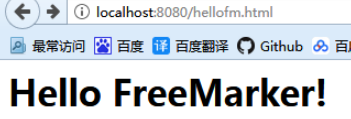
2.1.4 BeanNameViewResolver
引入 servlet 的 jar
1 <!--servlet 依赖 jar 包--> 2 <dependency> 3 <groupId>javax.servlet</groupId> 4 <artifactId>javax.servlet-api</artifactId> 5 <version>3.1.0</version> 6 </dependency>
自定义一个视图,然后声明成 bean,Controller 中返回这个 bean 的名字,就可以显示当前的视图:
1 public class HelloView implements View { { 2 public String getContentType() { { 3 return "text/html"; 4 } } 5 public void render(Map< < String, ?> model, HttpServletRequest request, 6 HttpServletResponse response) throws Exception { { 7 // 向相应中写入数据 8 response. getWriter().print( "Welcome to View:Hello"); 9 } } 10 } }
springMVC-servlet.xml 中配置:
1 <bean class="org.springframework.web.servlet.view.BeanNameViewResolver"> 2 <property name="order" value="10" /><!--优先级靠后--> 3 </bean> 4 <bean id="helloView" class="view.HelloView"/>
Controller
1 @RequestMapping( "helloview.html") 2 public String hello() { { 3 // 因为当前没有 helloView.jsp 4 // 所以视图解析器依次执行,找到 w id=helloView 的视图并显示 5 return "helloView"; 6 }
运行结果:
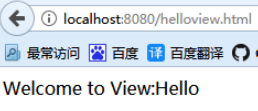
2.2 自定义 View
处理 json 数据需要 json 的 jar 包
1 <!-- Jackson Json 处理工具包 --> 2 <dependency> 3 <groupId>com.fasterxml.jackson.core</groupId> 4 <artifactId>jackson-databind</artifactId> 5 <version>2.7.4</version> 6 </dependency>
1 public class JsonView extends AbstractView { { 2 /** 3 * 该 w View 对应的输出类型 4 */ 5 @Override 6 public String getContentType() { { 7 return "application/json; charset=UTF- - 8"; 8 } } 9 // 向响应中写入数据 10 @Override 11 protected void renderMergedOutputModel(Map< < String, Object > model, 12 HttpServletRequest request,HttpServletResponse response) 13 throws Exception { { 14 ObjectMapper mapper = new ObjectMapper(); 15 // 设置 e Date 类型的格式,默认是显示毫秒数 16 mapper.setDateFormat( new SimpleDateFormat( "yyyy- - MM- - dd HH:mm:ss")); 17 // 需要注意的是放入 l model 的对象一定要实现 e Serializable 接口才能转化成 json 18 String jsonStr = mapper.writeValueAsString( model); 19 response. setContentType(getContentType()); 20 response. setHeader( "Cache- - Control", "no- - cache"); 21 response. setCharacterEncoding( "UTF- - 8"); 22 PrintWriter out = null; 23 try { { 24 out = response. getWriter(); 25 out.print( jsonStr); 26 out.flush(); 27 } catch ( IOException e e) { { 28 } finally { { 29 if ( out != null) { { 30 out.close(); 31 out = null; 32 } } 33 } } 34 } } 35 } }
测试代码:
1 @RequestMapping( "myview.html") 2 public ModelAndView myView() { { 3 Map< < String, Object > result = new HashMap <>(); 4 result. put( "key1", "123"); 5 result. put( "key2", new String[]{ { "a", "b"} }); 6 result. put( "key3", new Date()); 7 return new ModelAndView( new JsonView(), result); 8 } }
如果是 map 中的值是其它对象类型的,传给 ModelAndView 的数据必须有一个 modelName
2.3 转发和重定向
1 public String showView2() { 2 //转发前面加 forward: 3 return "index.html"; 4 } 5 @RequestMapping("/redirect.html") 6 public String showView3() { 7 //重定向前面加 redirect: 8 return "redirect:index.html"; 9 }
3. @ReponseBody
该注解用于将 Controller 的方法返回的对象,通过适当的 HttpMessageConverter 转换为指定格式后,写入到 Response 对象的 body 数据区。使用时机:返回的数据不是 html 标签的页面,而是其他某种格式的数据时(如 json、xml 等)使用。
3.1 返回 json 数据
处理 json 数据需要 json 的 jar 包
1 <!-- Jackson Json 处理工具包 --> 2 <dependency> 3 <groupId>com.fasterxml.jackson.core</groupId> 4 <artifactId>jackson-databind</artifactId> 5 <version>2.7.4</version> 6 </dependency
返回 json 类型的数据,需要在 spring 配置文件中加入如下配置:
1 <!--配置返回值转换器--> 2 <bean id="contentNegotiationManagerFactoryBean" 3 class="org.springframework.web.accept.ContentNegotiationManagerFactoryBean"> 4 <!--是否支持后缀匹配--> 5 <property name="favorPathExtension" value="true"/> 6 <!--是否支持参数匹配--> 7 <property name="favorParameter" value="true"/> 8 <!--是否 accept-header 匹配--> 9 <property name="ignoreAcceptHeader" value="false"/> 10 <property name="mediaTypes"> 11 <map> 12 <!--表示.json 结尾的请求返回 json--> 13 <entry key="json" value="application/json"/> 14 <!--表示.xml 结尾的返回 xml--> 15 <entry key="xml" value="application/xml"/> 16 </map> 17 </property> 18 </bean>
测试 favorPathExtension 请求后缀分别是.xml 和.json
测试 favorParameter 请求中参数 format=json 和 format=xml
测试 ignoreAcceptHeader,请求的 Header 中 Accept=application/json 或 Accept=application/xml
如果要返回 Xml,需要将要转换为 xml 的实体类上添加注解,如:
1 @XmlRootElement 2 public class Dept {
在<mvc:annotation-driven/>标签中指定 content-negotation-manager
1 <mvc:annotation-driven 2 content-negotiation-manager="contentNegotiationManagerFactoryBean"/>
测试类:
1 @Controller 2 @RequestMapping("/json") 3 public class JsonController { 4 @RequestMapping("/get ") 5 @ResponseBody//会自动将返回值转换成 json 6 public Dept getJson() { 7 Dept dept = new Dept(); 8 dept.setId(1); 9 dept.setName("张三"); 10 return dept; 11 } 12 }
测试结果:
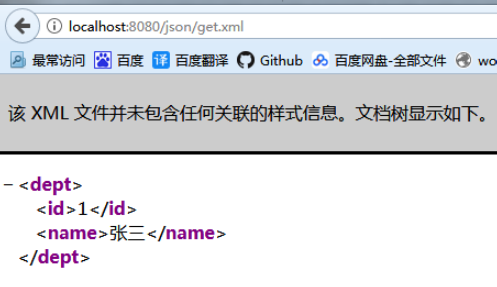

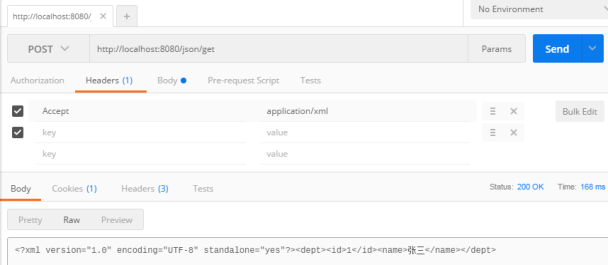
3.2 实现 RESTFUL
1 @RestController//相当于本类中所有的方法都加了@ResponseBody 2 @RequestMapping("/rest") 3 public class RestTestController { 4 //通过 method 限制请求的方式 5 @RequestMapping(value = "/{id}", method = RequestMethod. GET ) 6 public Dept getDept(@PathVariable Integer id) { 7 //模拟从数据库中查出一条数据 8 Dept dept = new Dept(); 9 dept.setId(id); 10 dept.setName("张三"); 11 return dept; 12 } 13 @RequestMapping(method = RequestMethod. POST ) 14 public Dept addDept(Dept dept) { 15 //模拟插入数据后生成主键 16 dept.setId(1); 17 System. out .println(dept.getName()); 18 return dept; 19 } 20 @RequestMapping(method = RequestMethod. PUT , consumes = "application/json") 21 public Dept updateDept(@RequestBody Dept dept) { 22 System. out .println(dept.getName()); 23 //执行修改的业务略 24 dept.setName("修改");//模拟修改名字 25 return dept; 26 } 27 @RequestMapping(value = "/{id}", method = RequestMethod. DELETE ) 28 public String deleteDept(@PathVariable Integer id) { 29 //执行删除的业务略 30 System. out .println(id); 31 return "删除成功"; 32 } 33 }
通过 postman 可以测试请求(ajax 方式无法测试 PUT 和 DELETE)。测试 put 的时候,请求的 body 设置为 raw,Headers 的 ContentType=application/json,否则会报 415:

注意类名上方的@RestController,相当于在类中每个方法上都添加了@ReponseBody。deleteDept 方法返回了一句 String 类型的提示信息,默认的 String 类型的返回值,编码是ISO-8859-1,中文会乱码,解决方案是在配置文件中修改编码:
修改<mvc:annotation-driven>节点,添加<mvc:message-converters>
1 <mvc:annotation-driven 2 content-negotiation-manager="contentNegotiationManagerFactoryBean"> 3 <!--String 返回值默认编码是 ISO-8859-1,需要--> 4 <mvc:message-converters> 5 <bean class="org.springframework.http.converter.StringHttpMessageConverter"> 6 <constructor-arg value="UTF-8" /> 7 </bean> 8 </mvc:message-converters> 9 </mvc:annotation-driven>
4 HttpEntity
HttpEntity 和@RequestBody 和@ResponseBody 类似,除了可以得到 request 和 response的 body 以外,还可以操作 header。
1 @RequestMapping("/entity.html") 2 public ResponseEntity<Dept> getEntity(RequestEntity<Dept> requestEntity) { 3 //获取请求头 4 String requestHeader = requestEntity.getHeaders().getFirst("MyRequestHeader"); 5 System. out .println(requestHeader); 6 Dept dept = new Dept(); 7 dept.setId(1); 8 dept.setName("张三"); 9 HttpHeaders responseHeaders = new HttpHeaders();//创建响应头 10 responseHeaders.set("MyResponseHeader", "MyValue");//自定义响应头 11 //响应对象 12 ResponseEntity<Dept> responseEntity = 13 new ResponseEntity<>(dept, responseHeaders, HttpStatus. OK ); 14 return responseEntity; 15 }
测试的页面:
1 <input type="button" onclick=" testEntity ()" value="测试 HttpEntity"/> 2 <script type="text/javascript"> 3 function testEntity (){ 4 $.ajax({ 5 type: "POST", 6 url: "/json/entity.html", 7 headers:{"MyRequestHeader":"abc"}, 8 success: function(data, status, xhr){//xhr 可以看到响应的头 9 alert(data.id); 10 alert(status); 11 alert("Header="+xhr.getResponseHeader("MyResponseHeader")); 12 }, 13 error: function(data, status, xhr){ 14 alert(data.id); 15 alert(status); 16 alert("Header="+xhr.getResponseHeader("MyResponseHeader")); 17 } 18 }); 19 } 20 </script>
本博客文章均已测试验证,欢迎评论、交流、点赞。
部分文章来源于网络,如有侵权请联系删除。
转载请注明原文链接:https://www.cnblogs.com/sueyyyy/p/9623586.html


 浙公网安备 33010602011771号
浙公网安备 33010602011771号